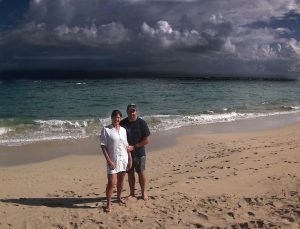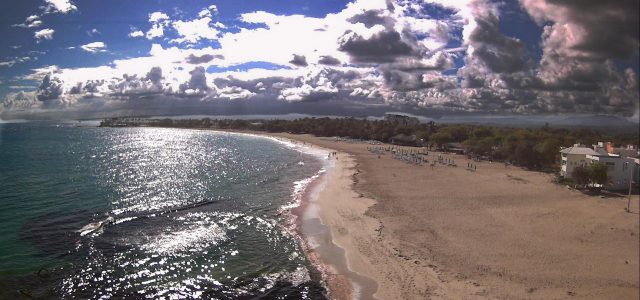My recent exposure into the world of drones has led me to using my 30 years of aviation experience to teach UAV ground schools and write documents for UAV operators in Canada. While my aviation roles cover several operational areas, my role as Flight Dispatcher, Private Pilot and Operations Manager have provided a wealth of knowledge that I apply to instruction and the safe operation of drones.
One of my passions is travel. Returning home with photographs of the places I visit with my wife are memories that will last a lifetime. For many, drones have changed the way photographs are taken while on vacation.
Our recent vacation to Playa Dorado in the Dominican Republic became my first opportunity to travel with a drone and attempt aerial photography in the Caribbean.
When purchasing a drone, I was looking for a lower priced design that had both GPS and a 1080 camera. I wasn’t prepared to commit to a high end, professional drone. I felt that I should gain flight and photo experience on a lower end model prior to committing financial resources to the more expensive models available. I knew that eventually I would open my wallet and go for an expensive drone that offered more bells and whistles and was designed for professional use. My dream-drone remains “to be determined” as there are many excellent options available to the pro consumer.
After much research, I selected the Helifar B3 Epik. The reviews on this drone were excellent, it came in under $300 and was equipped with GPS and a 1080 camera, which were a must. Additionally, mine came with a second battery which doubled my flying time. This came in handy when exploring remote locations where battery charging would be impossible. It also met my requirements for a drone that was portable, durable and could would remain steady in the wind.
We booked our vacation and began the packing process. Research into “travelling with a drone” provided insight from other experienced travelers that I found useful. It is important for all drone pilots to be aware of rules specific to the airline they are using. All airlines are slightly different. The restrictions are normally based on the discharge rate associated with the LiPo batteries our UAV’s use. In most cases, the batteries for drones are well below the maximum discharge rate allowed by airlines. In my case, the airline stipulated that the batteries had to be discharged and transported in my carry-on baggage. If you are unable to navigate the endless menus provided on the airline website, a quick call to their help desk should answer any questions you may have.
I am unaware of any airline that allows LiPo batteries to be transported in checked baggage. All checked bags are run through an x-ray system, so it is unlikely that batteries would pass through without being questioned. No traveler wants to be asked to open their checked bag and re-pack their luggage. Follow the rules and there should be no problems.
Once you find the information that relates to your transportation situation, I recommend that you print up the specifics and bring them with you to the airport on the day you travel. If you are prepared to answer any questions related to drone travel and provide documentation from the airline, your passage through the screening point should be carefree.
I discharged my two batteries and packed them in my carry-on bag, ensuring they were separate from any other electronic gear. I removed the props and packed the Helifar B3 in the Styrofoam case it arrived in when I purchased it and placed in my checked bag. I was careful to ensure that the storage case was strapped into the suitcase and firmly surrounded by resort wear. Working in the airline industry for 30 years I was fully aware of how checked bags were handled once they began their journey. While my airline did not restrict drones in my carry-on, I didn’t want to deal with the added questions sure to come up from the screening folks or fellow travelers.
Airport security was my next concern. While airlines and airport security are normally on the same page with restrictions on what is allowed onboard the aircraft, my experience shows that there are often inconsistencies, especially with something as new as UAVs and their power supply.
Passing through the screening point I was sure to be upfront with the screening agent about what I was carrying in my bag. I told him that my bag contained 2 discharged batteries for my drone and that my UAV was packed in my checked bag. He had no further questions and I proceeded through the screening point with ease. I had a print out of the rules specific to the airline I was flying on, however, the agent did not request to see it or challenge my battery claim.
My next concern was the safe arrival of my drone in Puerta Plata, DR.
We were happy to see our checked bags on the belt when we arrived. After a 20-minute drive to our resort where our room was waiting, I opened my suitcase and was thrilled to find my B3 in perfect condition. I attached the props, set up my batteries for charging and headed for the beach.
My goal for photography was to take shots of the shoreline and the surrounding mountains while maintaining a safe distance from tourists. I also wanted to be careful to respect the privacy of others. I didn’t want anyone to feel that I was photographing them.
I was also careful to review the rules for drone use in the Dominican Republic. As a strong proponent for drone use in Canada, it would be irresponsible of me to ignore the rules and regulations established in a foreign country. I would expect the same respect from drone pilots bringing their UAVs into Canada.
I was pleased to find that the restrictions around drone flight in the Dominican Republic were in line with what we see in North America:
- Do not fly over property unless you have consent from the property owner
- You must keep at least 50 feet laterally and 100 feet vertically from any person
- You cannot fly a drone weighing over 15 kg unless you have received permission from the aviation authorities
- Do not operate your drone in a careless or reckless manner
- You must maintain visual line of sight at all times with your drone
- Do not fly higher than 400 feet
- Only operate your drone during daylight hours
- You cannot operate within 8km (5 miles) of an airport or in any area that aircraft are present
- Do not fly your drone into restricted airspace
After reviewing these rules, I paid specific attention to the location of airports. POP was the closest airport to Playa Dorado Beach. Luckily our resort was just outside the 5-mile buffer zone. Also, I decided not to register my drone with Dominican Republic authorities. Some websites I visited mentioned registering drones while others did not. I did, however, have my Transport Canada drone registration with me and was prepared to show this to any officers who challenged me.

The golden beach of the north coast welcomed us as we made our way out of the foliage to the coast. Our first visit to the shore was a scouting on the afternoon of our arrival. I wanted to see the area and decide if flight would even be possible. We would be here for 1-week, so I was not in a rush to get airborne.
It was late afternoon and, as expected, the wind was up. I was in no mood to test the limits of my B3 Epik in winds that I felt would result in an unsafe operation. Additionally, my drone was not equipped with a stabilized gimbal to assist in smoothing out the photography. Wind was not my friend. I left the B3 in our room and waited for better flight conditions.
We enjoyed the remainder of our first day in this Caribbean paradise and made the decision to rise early and take to the skies in the morning. Many previous visits to the Dominican Republic and other island nations revealed calm mornings while afternoon sea breezes began to arrive around 11:00. A similar pattern would exist here as well, which was fine with me, as the beach was far more deserted early in the day.
The next morning, we made our way to the beach, drone in hand, all charged and ready to explore the coast from 300 feet up. We found a flat, isolated area of Play Dorado and built a landing pad with a beach towel and a few stones. I was worried about sand ingestion into the outrunners and our large beach towel did the trick. The area was also damp from overnight showers, which helped to keep the sand under control.
I powered up the drone by inserting the fully charged battery, connected the iPhone and radio, and calibrated the drone. Connection was easy, and confirmation of a full array of satellites meant we were ready to launch.
I briefed my wife as my visual observer. She gladly accepted her role and took the responsibility of monitoring beach traffic, relaying photo opportunities and ensuring visual line of sight. We both wore sunglasses to ensure we had protection against the bright morning sun. It also made scanning the empty sky easier.
From launch to recovery, the operation was seamless. We operated at a maximum altitude of 300 feet and never strayed more than 300 feet from our launch point. I was also careful not to test the limits of the battery. I never used more than 60% during any flight. Much of the operation had the drone flying over water, so I wanted to ensure I retained plenty of power to return home.
The morning sun and horizon clouds produced some dramatic results. The Caribbean has a beautiful combination of colors that make photography from altitude a pleasure. Every turn provided a new photo opportunity.
We flew 4 times during the week, producing approximately 100 photos of varying results. We were both extremely impressed with the quality of the photographs and will be printing several to include in our album.
On several occasions we were approached by curious beach-goers who wanted to ask questions. My wife did a great job of taking on the conversations, allowing me to concentrate on the task at hand.
For the return flight home, I did everything the same way as I did on the way down. Again, we were not challenged at the screening point and all equipment arrived back in Canada undamaged.
Aerial photography has changed the look of the albums we create when we return from our travels. Viewing these amazing locations from altitude has changed the way we vacation. We now have photos of things we can’t even see with our feet on the ground. We will never travel without a drone and luckily, airlines have accepted that drones are an item that have become commonplace. I have recently purchased a carrying case designed form my Helifar B3, making transportation even easier on future trips.
If you do some research before travel, pack properly and operate safely while respecting the foreign rules, you should embrace the idea of bringing your drone with you as you explore the world by air.
TEXT & PHOTOS BY GLENN WICKERT



















